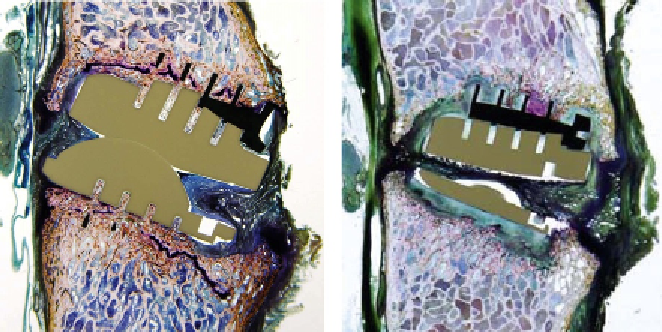Biomedical Engineering Reference
In-Depth Information
important aspect to be considered in the case of
PEEK is its chemical degradation when subjected to
UV irradiation. This kind of radiation is emitted by
the plasma, and even in the absence of oxygen such
as in an SPS or VPS process, polymer chain scissions
at the aromatic ether bond may occur as a result of
direct UV absorption, with consequent creation of
hydroxyl groups (
e
OH) and ester groups (O
e
C
]
O)
(see also
Fig. 9.10
). The result is a loss in mechanical
properties and discoloration
[78,82]
. Therefore, the
coating process must also be regulated in order to
minimize the exposure of the PEEK-based substrate
to UV radiation.
The coating of biomedical PEEK by plasma spray
can be dated back to at least a couple of decades. In
the 1990s, Ha et al.
[83,84]
published their experi-
ence with VPS Ti and HA coatings of highly carbon-
reinforced PEEK (
>
55% vol). Deposited sprayed
layers were demonstrated to completely coat the
substrate, reaching relatively high levels of roughness
(i.e.,
decrease (7%) in coating adhesion still lying within
the original relative variation of the measure.
More recently, Beauvais and Decaux
[86]
showed
that a chemically compliant HA coating could be
applied on plain PEEK by APS without affecting
tensile, flexural, and impact strength, whereas a non-
negligible effect was noticed on tensile elongation.
Moreover, the effect on PEEK of every single coating
process step was shown, from sandblasting to UV
plasma exposure to melted HA droplets projection. A
relatively poor adhesion strength between PEEK bulk
and coating was reached (7.5 MPa) when compared
with the ISO limit intended for a metal substrate
(15 MPa).
In recent international congresses, new data
[87
e
89]
have finally showed improved mechanical
adhesion strength. Bureau et al.
[87,88]
succeeded in
having adhesion of HA on CFR-PEEK of 20.9
2.1 MPa using a proprietary patent pending solution
consisting of a PEEK surface pretreatment through
an
m). These coatings were also shown in
overlapped configuration (HA onto Ti) and HA ful-
filled chemical composition requirements for clinical
application. In that time period, coating adhesion to
CFR-PEEK substrate was very poor (
<
3MPa)
[83]
,
and detrimental effects of the coating process on the
substrate mechanical strength were reported.
About 10 years later, Auclair-Daigle et al.
[85]
showed improved adhesion results for HA coating
applied to highly reinforced CF/PA12 composites via
APS. According to the specific substrate precoating
treatment, they reached adhesion values up to
22.9 MPa with relative variation of 14%. They also
showed that a subsequent immersion in simulated
body fluid (SBF) for up to 28 days causes a limited
R
a
~30
m
m-thick PEEK
e
HA
composite layers. Gisep and Wieling
[89]
showed
adhesion (22.2
overmolding
of
100-
m
6.5MPa) strength over standards and guideline
requirements (i.e., 22MPa) for titanium coatings
applied with a VPS-optimized process.
Finally, Gisep andWieling and Devine et al.
[89,90]
showed improved bone apposition and increase in
fixation for Ti-coated CFR-PEEK screws versus
uncoated through histological analysis and torque out
test after 6 months implantation time in sheep.
Also, Pioneer Surgical performed in vivo prelim-
inary evaluation to assess bone ongrowth onto HA-
coated PEEK. PEEK cervical disks, coated and
uncoated, were placed between vertebrae in sheep.
1.3MPa) and shear
(29.7
Figure 9.12
Histology after 3-
month implantation in sheep of
PEEK cervical disk prototypes:
(a) with HA coating and (b) without
HA coating. For the coated device,
a direct contact bone surface is
visible. In the uncoated device,
a thicker fibrotic tissue layer is
visible around the sample. Images
courtesy of Pioneer Surgical
(a)
(b)
Inc.,
Marquette, MI.

